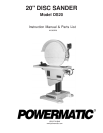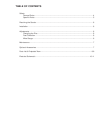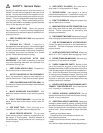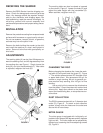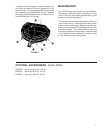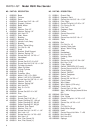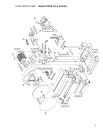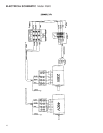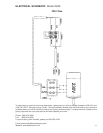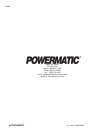
4
SAFETY: General Rules
As with all machines there is a certain amount of
hazard involved with the operation and use of this
sander. Use the machine with the respect and cau-
tion demanded where safety precautions are con-
cerned. This will considerably lessen the possibil-
ity of personal injury. When normal safety precau-
tions are overlooked or completely ignored, personal
injury to the operator can result.
1. KNOW YOUR TOOL. Read the owner’s
manual carefully. Learn the machine's applications
and limitations, as well as the specific potential haz-
ards peculiar to it.
2. KEEP GUARDS IN PLACE and maintained
in working order.
3. GROUND ALL TOOLS. If machine is
equipped with three-prong plug, it should be plugged
into a three-hole electrical receptacle. If an adapter
is used to accommodate a two-prong receptacle,
the adapter plug must be attached to a known
ground. Never remove the third prong.
4. REMOVE ADJUSTING KEYS AND
WRENCHES. Form habit of checking to see that
keys and adjusting wrenches are removed from
tool before turning it on.
5. KEEP WORK AREA CLEAN. Cluttered ar-
eas and benches invite accidents.
6. AVOID DANGEROUS ENVIRONMENT.
Don’t use machines in damp or wet locations, or
expose them to rain. Keep work area well lighted.
7. KEEP CHILDREN AND VISITORS AWAY. All
children and visitors should be kept a safe distance
from work area.
8. MAKE WORKSHOP CHILDPROOF - with
padlocks, master switches, or by removing starter
keys.
9. DON’T FORCE MACHINE. It will do the job
better and be safer at the rate for which it was de-
signed.
10. USE RIGHT TOOL. Don’t force tool or at-
tachment to do a job it was not designed for.
11. WEAR PROPER APPAREL. Do not wear
loose clothing, gloves, neckties, or jewelry that can
get caught in moving parts. Nonslip footwear is
recommended. Wear protective hair covering to
contain long hair
12. USE SAFETY GLASSES. Also use face or
dust mask if cutting operation is dusty.
13. SECURE WORK. Use clamps or a vise to
hold work when practical. It’s safer than using your
hand and frees both hands to operate machine.
14. DON’T OVERREACH. Keep your proper foot-
ing and balance at all times.
15. MAINTAIN TOOLS IN TOP CONDITION. Keep
tools sharp and clean for best and safest perfor-
mance. Follow instructions for lubricating and
changing accessories.
16. DISCONNECT MACHINE before servicing and
when changing accessories such as chisel and bit.
17. USE RECOMMENDED ACCESSORIES.
Consult the owner’s manual for recommended ac-
cessories. The use of improper accessories may
cause hazards.
18. AVOID ACCIDENTAL STARTING. Make sure
switch is in “OFF” position before plugging in cord.
19. NEVER STAND ON MACHINE. Serious injury
could occur if the machine is tipped.
20. CHECK DAMAGED PARTS. Before further
use of the machine, a guard or other part that is
damaged should be carefully checked to ensure that
it will operate properly and perform its intended func-
tion - check for alignment of moving parts, binding
of moving parts, breakage of parts, mounting, and
any other conditions that may affect its operation.
A guard or other part that is damaged should be
properly repaired or replaced.
21. NEVER LEAVE MACHINE RUNNING UNAT-
TENDED. TURN POWER OFF. Don’t leave sander
until it comes to a complete stop.
22. DRUGS, ALCOHOL, MEDICATION. Do not
operate machine while under the influence of drugs,
alcohol, or any medication.
23. ADDITIONAL HEALTH HAZARDS. Some dust
created by power sanding, sawing, grinding, drilling
and other construction activities contains chemicals
known to cause cancer, birth defects or other repro-
ductive harm. Some examples of these chemicals
are:
* Lead from lead-based paint.
* Crystalline silica from bricks and cement and
other masonry products.
* Arsenic and chromium from chemically-treated
lumber.
Your risk from these exposures varies, depending on



